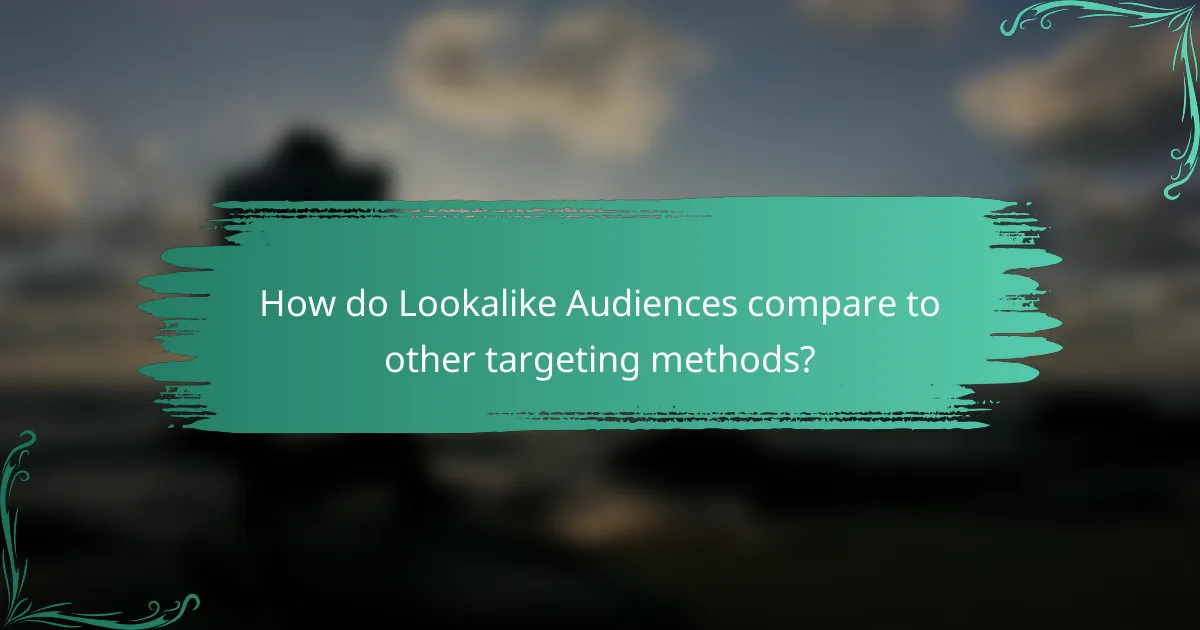Lookalike Audiences play a crucial role in enhancing display advertising by enabling marketers to target individuals who share similarities with their current customers. By utilizing data-driven profiles, advertisers can effectively reach potential clients, resulting in improved campaign performance. Understanding your source audience and employing tools like Facebook Ads Manager are essential for creating successful Lookalike Audiences that drive better outcomes.

How do Lookalike Audiences enhance Display Advertising?
Lookalike Audiences improve display advertising by allowing marketers to target users who resemble their existing customers. This method leverages data to create profiles that help advertisers reach potential clients more effectively, leading to better campaign outcomes.
Increase targeting precision
Lookalike Audiences enhance targeting precision by analyzing the characteristics of your best customers and finding new users with similar traits. This process often involves demographic data, online behavior, and interests, ensuring that your ads reach individuals who are more likely to engage with your brand.
To maximize targeting effectiveness, regularly update your source audience to reflect current customer trends. This practice helps maintain relevance and increases the likelihood of successful conversions.
Boost conversion rates
By targeting users who closely match your existing customers, Lookalike Audiences can significantly boost conversion rates. Since these users share similar interests and behaviors, they are more inclined to respond positively to your advertising efforts.
Consider A/B testing different ad creatives and messages tailored for Lookalike Audiences to identify what resonates best. This approach can lead to higher engagement and improved return on ad spend (ROAS).
Expand reach to similar users
Lookalike Audiences allow advertisers to expand their reach by tapping into a broader pool of potential customers who are similar to their existing clientele. This strategy not only increases brand visibility but also enhances the chances of attracting new customers.
Utilize platforms like Facebook and Google Ads, which offer built-in tools for creating Lookalike Audiences. By specifying the percentage of similarity (typically between 1% to 10%), you can control how closely the new audience matches your existing customers, balancing reach and relevance effectively.

What are the best practices for creating Lookalike Audiences?
Creating effective Lookalike Audiences involves understanding your source audience and leveraging tools like Facebook Ads Manager. By following best practices, you can enhance your display advertising success and reach potential customers who closely resemble your existing audience.
Define source audience criteria
Start by identifying the characteristics of your source audience, which can include demographics, interests, and behaviors. A well-defined source audience typically consists of your most valuable customers, such as those who have made recent purchases or engaged significantly with your brand.
Consider using a source audience size of at least a few hundred individuals to ensure Facebook has enough data to create an effective Lookalike Audience. The more specific your criteria, the better the chances of finding similar users who are likely to convert.
Utilize Facebook Ads Manager
Facebook Ads Manager is a powerful tool for creating and managing Lookalike Audiences. Navigate to the ‘Audiences’ section, where you can select your source audience and specify the desired size of your Lookalike Audience, typically ranging from 1% to 10% of the population in your target country.
When setting up your audience, ensure you choose the right location and language settings to align with your advertising goals. This will help you reach users who are not only similar to your source audience but also likely to engage with your ads.
Test audience variations
Testing different variations of your Lookalike Audiences can lead to better results. Create multiple Lookalike Audiences based on different source audiences or adjust the percentage size to see which performs best in terms of engagement and conversions.
Monitor the performance of each audience variation closely. Use A/B testing to compare metrics like click-through rates and return on ad spend, allowing you to refine your targeting strategy over time for optimal performance.

What metrics measure Lookalike Audience effectiveness?
Lookalike Audience effectiveness is primarily measured through key performance indicators such as Return on Ad Spend (ROAS), Click-through Rates (CTR), and Cost per Acquisition (CPA). These metrics help advertisers assess how well their campaigns are performing and whether their lookalike targeting is yielding positive results.
Return on ad spend (ROAS)
Return on Ad Spend (ROAS) quantifies the revenue generated for every dollar spent on advertising. A higher ROAS indicates that your lookalike audience is effectively converting, making it a critical metric for evaluating campaign success. Aim for a ROAS of at least 4:1 to ensure profitability, but this can vary by industry.
To calculate ROAS, divide the total revenue from your ads by the total ad spend. For example, if you earn $10,000 from a $2,000 ad spend, your ROAS would be 5:1. Regularly monitor this metric to adjust your strategies as needed.
Click-through rates (CTR)
Click-through Rate (CTR) measures the percentage of users who click on your ad after seeing it. A higher CTR suggests that your lookalike audience finds your ads relevant and engaging. Generally, a CTR of 2% to 5% is considered good, but this can differ based on the platform and industry.
To improve CTR, focus on creating compelling ad copy and visuals that resonate with your target audience. A/B testing different headlines and calls to action can help identify what drives the most engagement.
Cost per acquisition (CPA)
Cost per Acquisition (CPA) indicates how much you spend to acquire a new customer through your advertising efforts. Lower CPA values suggest that your lookalike audience is responding well to your campaigns. Aim for a CPA that aligns with your product’s lifetime value to maintain profitability.
To calculate CPA, divide your total ad spend by the number of conversions. For instance, if you spend $1,000 and acquire 50 customers, your CPA is $20. Keep an eye on this metric to ensure your advertising remains cost-effective.

What challenges exist with Lookalike Audiences?
Lookalike audiences can enhance display advertising effectiveness, but they come with several challenges that marketers must navigate. Key issues include data privacy concerns, the quality of the source audience, and overlapping audiences that can dilute targeting precision.
Data privacy concerns
Data privacy is a significant challenge when using lookalike audiences, especially with regulations like GDPR in Europe and CCPA in California. Marketers must ensure that the data used to create these audiences complies with legal standards, as violations can lead to hefty fines and reputational damage.
To mitigate privacy risks, businesses should prioritize transparency with users regarding data collection and usage. Implementing robust consent management practices can help build trust and ensure compliance with privacy regulations.
Quality of source audience
The effectiveness of lookalike audiences heavily relies on the quality of the source audience. If the original audience is not well-defined or lacks engagement, the lookalike audience may not perform as expected. It’s crucial to analyze the characteristics of the source audience to ensure it represents your best customers.
To improve the quality of your source audience, focus on gathering data from highly engaged users. This can include analyzing purchase behavior, website interactions, and demographic information to create a more accurate and effective lookalike audience.
Overlapping audiences
Overlapping audiences can complicate targeting strategies, leading to wasted ad spend and reduced campaign effectiveness. When multiple lookalike audiences share common traits, it can be challenging to determine which audience to prioritize for specific campaigns.
To manage overlapping audiences, consider segmenting them based on distinct characteristics or behaviors. This allows for more tailored messaging and can enhance the overall performance of your display advertising efforts.

How do Lookalike Audiences compare to other targeting methods?
Lookalike Audiences are a powerful targeting method that allows advertisers to reach new potential customers who share characteristics with their existing audience. Compared to other targeting strategies, they often yield higher engagement and conversion rates due to their focus on similar traits and behaviors.
Versus Custom Audiences
Custom Audiences target users based on specific data you already have, such as email lists or website visitors. This method is effective for re-engaging existing customers but lacks the broader reach that Lookalike Audiences provide. By using Lookalike Audiences, you can expand your reach to new users who resemble your best customers, potentially increasing your market size.
When implementing both strategies, consider starting with Custom Audiences to nurture existing relationships, then leverage Lookalike Audiences to attract similar prospects. This combination can enhance overall campaign effectiveness.
Versus Interest-based targeting
Interest-based targeting focuses on users based on their declared interests and behaviors, allowing for a more generalized approach. While this method can effectively reach specific demographics, it may not always connect with users who are likely to convert. Lookalike Audiences, on the other hand, are based on actual customer data, making them more likely to resonate with potential buyers.
To maximize your targeting efforts, consider using both strategies in tandem. Start with interest-based targeting to gather data and insights, then refine your approach by creating Lookalike Audiences that mirror your most engaged users. This dual strategy can lead to improved ad performance and higher return on investment.

What tools support Lookalike Audience strategies?
Several tools can enhance Lookalike Audience strategies, enabling advertisers to reach new customers similar to their existing ones. These platforms leverage data analytics and user behavior to identify potential audiences effectively.
Google Ads
Google Ads allows advertisers to create Lookalike Audiences by using existing customer data to find new users across Google’s vast network. By uploading customer lists or utilizing website visitor data, advertisers can target similar profiles based on demographics, interests, and online behavior.
To optimize your Lookalike Audience in Google Ads, ensure your customer data is clean and segmented. Regularly update your audience lists to reflect recent customer interactions, which can improve targeting accuracy. Consider testing different audience sizes to find the balance between reach and relevance.
AdRoll
AdRoll offers a robust platform for building Lookalike Audiences by analyzing user interactions across various channels, including social media and email. By integrating with your existing customer data, AdRoll can identify and target potential customers who share similar characteristics with your best-performing segments.
When using AdRoll, focus on creating high-quality audience segments based on specific behaviors, such as past purchases or website engagement. This targeted approach can enhance your ad performance and increase conversion rates. Regularly monitor campaign results to refine your audience targeting and improve overall effectiveness.
